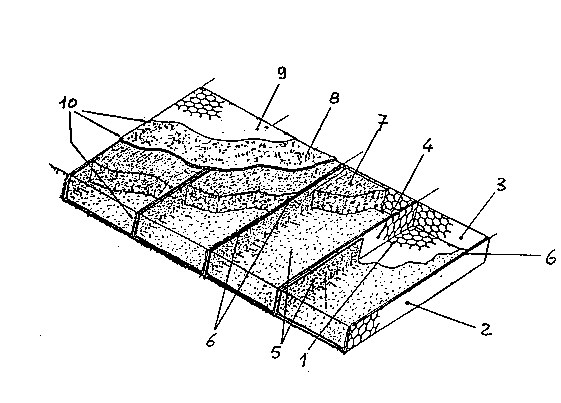Some of the information on this Web page has been provided by external sources. The Government of Canada is not responsible for the accuracy, reliability or currency of the information supplied by external sources. Users wishing to rely upon this information should consult directly with the source of the information. Content provided by external sources is not subject to official languages, privacy and accessibility requirements.
Any discrepancies in the text and image of the Claims and Abstract are due to differing posting times. Text of the Claims and Abstract are posted:
| (12) Patent Application: | (11) CA 2091396 |
|---|---|
| (54) English Title: | PROCEDURE FOR THE CREATION OF MATTRESS TYPE GABIONS FOR PROTECTIVE VEGETABLE REVETMENTS |
| (54) French Title: | PROCEDE POUR PROTEGER UN SOL A L'AIDE DE GABIONS FORMANT UN MATELAS FAVORISANT LA CROISSANCE DE VEGETAUX |
| Status: | Deemed Abandoned and Beyond the Period of Reinstatement - Pending Response to Notice of Disregarded Communication |
| (51) International Patent Classification (IPC): |
|
|---|---|
| (72) Inventors : |
|
| (73) Owners : |
|
| (71) Applicants : |
|
| (74) Agent: | MACRAE & CO. |
| (74) Associate agent: | |
| (45) Issued: | |
| (22) Filed Date: | 1993-03-10 |
| (41) Open to Public Inspection: | 1994-09-11 |
| Availability of licence: | N/A |
| Dedicated to the Public: | N/A |
| (25) Language of filing: | English |
| Patent Cooperation Treaty (PCT): | No |
|---|
| (30) Application Priority Data: | None |
|---|
PROCEDURE FOR THE CREATION OF MATTRESS TYPE GABIONS FOR
PROTECTIVE VEGETABLE REVETMENTS
ABSTRACT
PROCEDURE FOR THE CREATION OF MATTRESS GABIONS for soil
revetments, designed to halt erosion and/or to consolidate
the soil, characterised by a protective vegetable revetment
consisting of the structure within the mattress which
retains the soil inside each individual cell. The invention
allows each cell of the container to be filled with earth or
another earth mixture, encouraging the growth of vegetation
inside the mattress in order to afford a natural protection
to the soil of banks or escarpments, etc. After it has been
filled, the mattress is closed by a top cover in double
twist steel mesh, after laying a geosynthetic sheet between
the two to keep in fine materials.
Note: Claims are shown in the official language in which they were submitted.
Note: Descriptions are shown in the official language in which they were submitted.

2024-08-01:As part of the Next Generation Patents (NGP) transition, the Canadian Patents Database (CPD) now contains a more detailed Event History, which replicates the Event Log of our new back-office solution.
Please note that "Inactive:" events refers to events no longer in use in our new back-office solution.
For a clearer understanding of the status of the application/patent presented on this page, the site Disclaimer , as well as the definitions for Patent , Event History , Maintenance Fee and Payment History should be consulted.
| Description | Date |
|---|---|
| Inactive: IPC expired | 2018-01-01 |
| Inactive: IPC from MCD | 2006-03-11 |
| Time Limit for Reversal Expired | 2001-03-12 |
| Application Not Reinstated by Deadline | 2001-03-12 |
| Deemed Abandoned - Failure to Respond to Maintenance Fee Notice | 2000-03-10 |
| Inactive: Abandon-RFE+Late fee unpaid-Correspondence sent | 2000-03-10 |
| Application Published (Open to Public Inspection) | 1994-09-11 |
| Abandonment Date | Reason | Reinstatement Date |
|---|---|---|
| 2000-03-10 |
The last payment was received on 1999-03-04
Note : If the full payment has not been received on or before the date indicated, a further fee may be required which may be one of the following
Patent fees are adjusted on the 1st of January every year. The amounts above are the current amounts if received by December 31 of the current year.
Please refer to the CIPO
Patent Fees
web page to see all current fee amounts.
| Fee Type | Anniversary Year | Due Date | Paid Date |
|---|---|---|---|
| MF (application, 5th anniv.) - standard | 05 | 1998-03-10 | 1998-03-03 |
| MF (application, 6th anniv.) - standard | 06 | 1999-03-10 | 1999-03-04 |
Note: Records showing the ownership history in alphabetical order.
| Current Owners on Record |
|---|
| OFFICINE MACCAFERRI S.P.A. |
| Past Owners on Record |
|---|
| FRANCESCO FERRAIOLO |